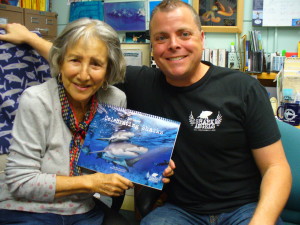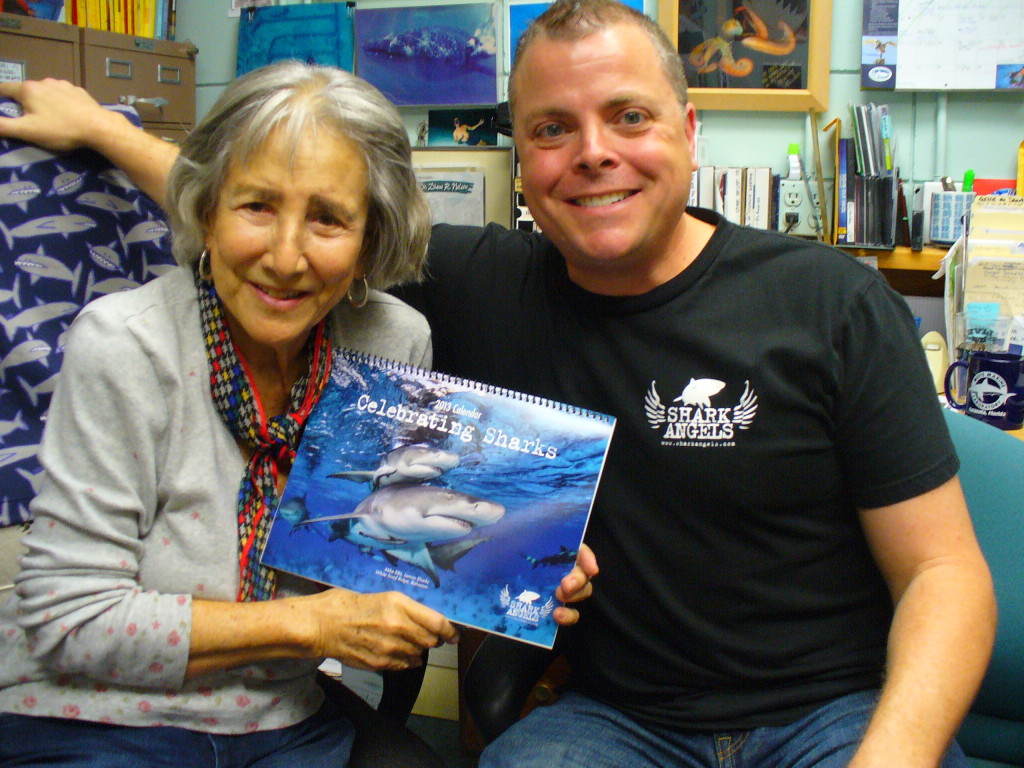
Eugenie Clark, referred to as The Shark Lady, is a pioneer, an explorer, a scientist, a writer, and an inspiration to thousands around the world. She’s always been a strong spirit, never letting anything hold her back; her courage and determination combined with her intelligence has made her a legend and her list of achievements lengthy. She is a visionary and leader in the field of shark behavior. She is the founder of the Mote Marine Laboratory and Aquarium, formerly known as the Cape Haze Marine Laboratory – a tribute to her love for the oceans and science for generations to come. Her research is widely acclaimed and has been funded by the National Geographic Society, NOAA, the National Science Foundation, and the Smithsonian Institution. Never at a loss for words, she has written 3 books: Lady with a Spear, The Lady and the Sharks, and The Desert Beneath the Sea. And to top it off she is still working at the Mote at the age of 90.
It’s not often you get to meet someone you have always idolized. It is great when that person more than lives up to your expectations. I happened to be at a National Geographic lecture by the photographer David Doubilet, when I heard Dr. Clark speak up during the question and answer portion of the event. After the show, I screwed up my courage and asked her if I could interview her for Shark Angels. She couldn’t have been more accommodating, as well as her research assistant Rachel Dreyer. I eagerly arrived for the interview, her office teeming with any shark item you could imagine, as well as photographs from her adventures, and books written by her peers. It was exactly the way you would think it would be. With my gift of a Shark Angels calendar and my nervous excitement in check, I sat down and had an amazing chat, realizing that Dr. Clark is just as incredible as she seems.
What part of the New York Aquarium at Battery Park ignited your curiosity the most when you were a child hanging out there on Saturdays?
All of it. I would stand on the railing so I could get my face close to the glass. That way I could pretend I was underwater with the sharks swimming all around me. Then I thought I want to do that some time. I want to go into the sea and see a shark.
Most research today is applied, because it is the type that is easier to solicit funding. What argument would you use to get support for basic research? It’s fundamental knowledge. You have to start off with algebra, trigonometry, and geometry. You have to start with the basics. Then you understand from the bottom up. You have to know how these animals are working. Otherwise, you won’t understand the different species and different types of animals. It is important to get as much of the basics as you can. It is the cooperation between the book people and the field people that make it work. There are very few, and I am one of the lucky ones, that have experience in both sides. That cooperation really helps us understand the ocean and the animals in it.
What accomplishment are you most proud of in your life?
I guess it’s nice to specialize in something and then get to communicate that to people. Also, I have done a lot of writing, both popular and scientific. I have been able to do a lot of lectures, interviews and a lot of television shows. I am happy that I am able to share that with people and children.
What do you see as the next big frontier in shark research?
Unfortunately, it’s getting into molecular biology. I love fish and I love ichthyology. So much work now is done on DNA and in the labs. It’s getting boring to me. The best is the combination (of field and lab work). When you go out and study an animal and come back and write it up. We found a new species of mollusk, an eel like fish where the babies feed the mother. The adults stay in tunnels and don’t come out any more. We had only seen the adults from the samples we collected and kept in the lab and raised them. No one had ever collected one out in the field. Every night thousands of the babies come back after feeding on plankton all day long. They hang on the roof of the tunnels by their heads using a mucus disk and they feed the adults by upchucking . It is the only known animal where the babies nourish the adults. We got an engineer to design a camera to go in to the tunnel and watch them. We had a lot of fun with that study.
You had already written two nonfiction books. What made you decide to write a children’s book?
Ann McGovern, a writer of over 70 children’s books, first wrote a children’s book about me. She asked me what work I was doing that wasn’t so “sharky”. I told her I like the sandy areas around the coral reef. So many things are living in that sand. So many fish make it their home, but they disappear so when you go down you just see a wide expanse of sand. You don’t realize how much is living under the sand. So we wrote the children’s book Desert Beneath the Sea. We are thinking about going to the Caribbean and studying garden eels. My children’s book even got reviewed in some scientific books.
Deep submersible dives, like space exploration, are not something very many people get to experience. After 70+ dives does it become second nature, or is there always that feeling that you are doing something special?
I have done 73. It’s always a thrill. We have been studying the six gill shark. (she points to a picture with a six gill shark with another in its mouth) One of them was swimming with its mouth wide open and turned around and bumped into each other. It looks like they are biting one another, but they’re not. It was a mistake. I wrote a paper on it (Deep-Sea Elasmobranchs Observed from Submersibles off Bermuda, Grand Cayman, and Freeport, Bahamas).
The shark most people are aware of or are excited by is the white shark. Is there a particular shark other than the white shark that interests you the most?
I like them all for different reasons. Whale sharks are certainly fantastic. I wrote a paper with some Taiwanese people. Nobody knew whether whale sharks laid eggs or had live babies. When I went to Taiwan and talked to whale shark fisherman they said the babies come out alive. We got a rich Taiwanese sportsman to bring in a big female for us to dissect. We found over 300 babies inside of her. The number is so much larger than any other shark.
Do you still have a soft spot for the Serranus?
Of course, and they are all around here. Nobody studies them anymore. They can change sex in ten seconds. They mate as a male and then ten seconds later come up and mate as a female. They exchange gonadal material that way. It’s a remarkable animal to study.
Who is the next rock star of marine research? And what are they working on?
Dr. Nick Whitney is doing some of the most exciting research. He is a good speaker. He is the up and coming researcher.
What is one thing most people don’t know and wouldn’t expect about you?
(Her research assistant spoke up) She has had 5 husbands.
Any final words to inspire those who love and want to protect the oceans?
There are two ways to go. The first is to actually be in the ocean as much as you can or to study about the ocean all the way back to elementary school. We need to study math and physics so we can understand the whole dynamics of the ocean. There are so many ways to ramify if you love the oceans. You can be a quadriplegic and study about the ocean. You don’t have to get in it, but those of us who do love that aspect of it perhaps more than anything.
I had a wonderful time. The Mote Marine Laboratory and Aquarium (1600 Ken Thompson Parkway Sarasota, FL 34236) is a wonderful place for kids of all ages to explore and is also involved in a lot of cutting edge shark research. I got a chance to see a little behind the scenes and was extremely impressed. I highly recommend that anyone traveling close to the Sarasota area visit and experience the things that the aquarium has to offer. And, I am already looking forward to lunch she promised to have with me.








1 Comment
Pingback: "Shark Lady" Marine Biologist Eugenie Clark Immortalized on Stamp - The Scuba News Canada